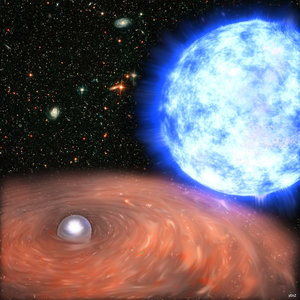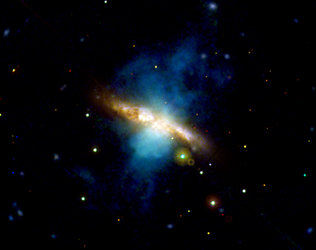Fire burn and cauldron bubble
The cosmic cauldron has brewed up a Halloween trick in the form of a ghostly face that glows in X-rays, as seen by ESA’s XMM-Newton space telescope. The eerie entity is a bubble bursting with the fiery stellar wind of a ‘live fast, die young’ star.
The bubble lies 5000 light-years from Earth in the constellation of Canis Major, the ‘greater dog’, and can be imagined to take on a dog- or wolf-like face.
It spans nearly 60 light-years across and was blown by the powerful stellar wind of the Wolf-Rayet star HD 50896 – the pink star near the centre of the image that makes up one of the object’s piercing eyes.
Wolf-Rayet bubbles are the result of a hot, massive star – typically greater than 35 the mass of our Sun – expelling material through a strong stellar wind. This star’s howling wind is a million-degree plasma potion that emits X-rays, represented in blue in this image.
Where this fierce wind ploughs into surrounding material it is lit up in red tones as seen in the ‘cheek’ of the face.
The green halo is a result of a shock wave racing out from the star and colliding with the layers of stellar material already ejected into space.
A ‘blow-out’ of X-ray emission at the top left gives the wolf an ear, and a denser region to the bottom right can be likened to a snout.
The witching hour will soon come for this bubble and its star. The bubble will burst and disperse into the surrounding environment, while the star will end its life in a dramatic supernova explosion.
X-Ray Emission from the Wolf-Rayet Bubble S 308 by J. Toala et al is published in the Astrophysical Journal 755, 77 (2012).















 Germany
Germany
 Austria
Austria
 Belgium
Belgium
 Denmark
Denmark
 Spain
Spain
 Estonia
Estonia
 Finland
Finland
 France
France
 Greece
Greece
 Hungary
Hungary
 Ireland
Ireland
 Italy
Italy
 Luxembourg
Luxembourg
 Norway
Norway
 The Netherlands
The Netherlands
 Poland
Poland
 Portugal
Portugal
 Czechia
Czechia
 Romania
Romania
 United Kingdom
United Kingdom
 Slovenia
Slovenia
 Sweden
Sweden
 Switzerland
Switzerland







































